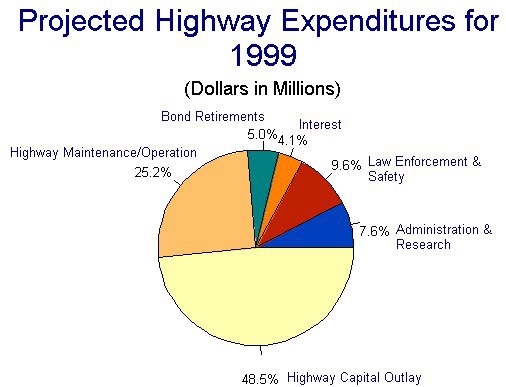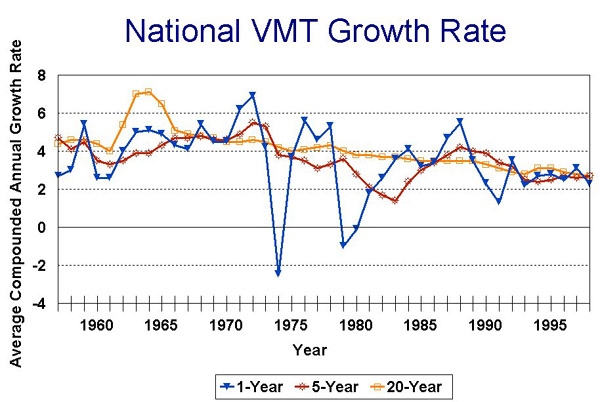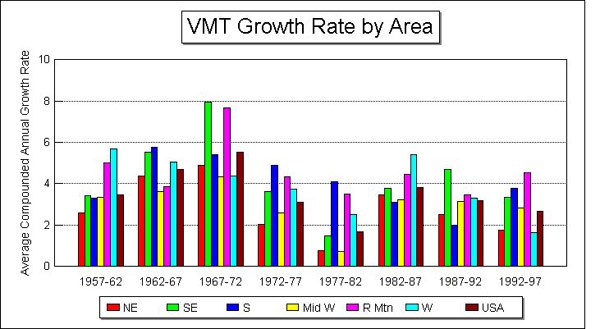FHWA Updates Highway Statistics Guide
The Guide to Reporting Highway Statistics (Guide) provides for the collection of information that describes policies and procedures for assembling statistical data from the existing files of State agencies on motor-vehicle registration and fees, motor-fuel use and taxation, driver licensing, highway taxation and finance, and other related subjects, and the reporting of these data to the Federal Highway Administration. FHWA's next Guide will provide for more detailed State highway spending information and begin phasing in major improvement to state motor-fuel reporting.
The Guide was first issued in 1979 to bring all the forms and instructions together in one place. It has been updated every 3 years prior to submittal for Office of Management and Budget review. The transportation data reported through the Guide, along with roadway and travel information collected through the Highway Performance Monitoring System, are published by FHWA in Highway Statistics, Highway Taxes and Fees--How They are Collected and Distributed, Monthly Motor Fuel Reported by States, and Our Nation's Highways--Selected Facts and Figures. The data collected under the Guide are of great assistance to Congress, FHWA, other U.S. DOT and Federal agencies, State and local governments, and various interest groups. The Status of the Nation's Surface Transportation System: Condition and Performance Report to Congress (the Needs Report) is one report that relies on these data.
The FHWA's Office of Highway Policy Information (OHPI) is in the process of revising the Guide. As part of this process, OHPI is continuing to solicit comments from data users and providers. The current Guide can be found at the Web site: https://www.fhwa.dot.gov/policy/ohpi/hss/guide.htm under "Highway Statistics Series." For additional information, please contact Mike Neathery, Highway Funding and Motor Fuel Division, at (202) 366-0170 or E-mail at Mike.Neathery@fhwa.dot.gov.
Highway Statistics Publication
Instead of printing the entire annual Highway Statistics report, the Office of Highway Policy Information is considering providing the complete report as an electronic document on the Internet and on CD-Rom. An abridged printed version would be produced as a collection of the most frequently used tables. (See "What's New" on our Internet site for a list of these tables.) Your comments on this subject are welcomed; please contact Mary K. Teets at (202) 366-9211 or E-mail Mary.Teets@fhwa.dot.gov.
Four HPMS Implementation Workshops Held
The Office of Highway Policy Information held four Highway Performance Monitoring System (HPMS) implementation workshops in February and March. The workshops included participants from most States, several metropolitan planning organizations (MPO's), and FHWA field offices responsible for providing HPMS data and were directed at discussing changes to the HPMS brought about by the recently completed HPMS reassessment. Plans call for implementing new HPMS requirements with the reporting of 1999 data in June 2000. The workshops were held at this time so that States and other providers can collect 1999 data throughout the year in accordance with new procedures; the workshops were also intended to give States a head start in making needed data system changes.
As a result of valuable input from workshop participants, FHWA made some additional changes to the reporting requirements proposed in the Highway Performance Monitoring System Reassessment--Final Report, December 1998. An addendum to that report containing the additional changes to the HPMS reporting requirements was distributed to the States, FHWA field offices, and those on the HPMS reassessment outreach mailing list. It was also posted on the FHWA Internet Web site at https://www.fhwa.dot.gov/ohim/fin_rpt.pdf.
A Microsoft Powerpoint file of the workshop presentation is available from FHWA on request. Contact: James Getzewich at (202) 366-0175 or E-mail Jim.Getzewich@fhwa.dot.gov.
FHWA's Motor Fuel Reporting Reassessment Makes Progress
As reported in an earlier Highway Information Quarterly (Vol.6, No. 1, March 1999), the committee for the Reassessment of FHWA's Motor Fuel Reporting met on December 10-11, 1998, to recommend improvements to motor fuel reporting. Some of the areas of reporting shortcomings were already identified by FHWA and include items such as the fuel sales on Native American reservations, audit assessments, loss allowances for motor fuels, highway versus non-highway exemptions and refunds, government use of motor fuels, and alternative fuels. The committee determined several areas where additional research is necessary. Four subcommittees were commissioned to pursue the following issues.
-- The first subcommittee will survey the States to determine what motor fuel data States can currently provide. The purpose of this survey is to develop a better understanding of what data States may be able to report. An example of shortcomings of past reporting was many States inability to report public use of motor fuel, which led FHWA to determine that public-use reporting would not be required. As a result, those States that did collect the data could not then count it as a highway use of motor fuel. The survey will, therefore, help FHWA determine how to handle situations such as the one described.
-- The second subcommittee will recommend what uniformity is needed in definitions between FHWA guidance, Internal Revenue Service regulations, and the Federation of Tax Administration's Task Force on Uniformity. While it is clear a uniform set of definitions would improve general consistency in reporting of motor fuel data, it will also make communication easier, and could possibly help in other areas such as combating tax evasion.
-- A third subcommittee will recommend what needs to be developed to better define the International Fuel Tax Agreement (IFTA) process and IFTA reporting in the FHWA guidance. The IFTA process is a great improvement over former Interstate motor carriers tax reporting, but the Guide to Reporting Highway Statistics (Guide) needs updated guidance for properly reporting Interstate motor fuel. The subcommittee will develop material to supplement existing guidance.
-- The fourth subcommittee will determine what can be done to better describe the FHWA attribution process. FHWA policy has specified the basic process used to attribute motor fuel data, but a thorough explanation of the process with supplementary materials such as flow diagrams and other communication tools need to be developed to supplement the Guide and to open the process to a wider audience.
Minutes of the December 10 meeting are available and can be found in the "What's New at OHPI" section at the Web site: https://www.fhwa.dot.gov/ohim/mfcpage.htm
Over the next several months, the issues identified at that meeting will be studied in more detail, and recommendations developed. In another meeting to be held September 23-24, 1999, the committee will hear the result of the subcommittee work and make concrete recommendations. FHWA will then hold workshops in the vicinity of the four FHWA Resource Centers to present the results of the committee's recommendations and solicit further input.
The final results of the motor fuel reassessment effort will be incorporated into future editions of the FHWA Guide. As part of the implementation process, OHPI is planning to hold training sessions to assist the States and FHWA field offices in the transition to the new procedures.
Additional information can be obtained by contacting Ralph Erickson at (202) 366-9235 or E-mail Ralph.Erickson@fhwa.dot.gov.
The Federal Highway Administration's (FHWA's) Office of Highway Policy Information recently released its annual bulletin, Highway Funding 1996-1999. This bulletin portrays a "snapshot" of highway revenues and disbursements by all units of government. Total disbursements are expected to exceed $110 billion in 1999, an increase of 12.4 percent over 1996.
Total anticipated 1999 highway-user revenues of $101.3 billion (motor fuel, motor vehicle taxes and fees, and tolls) would fund about 92 percent of all highway disbursements. The difference between disbursements and highway-user revenue results from some highway-user revenues going to non-highway purposes, and non-user revenues being applied for highway purposes.
Capital expenditures are expected to increase in 1999 to about $53.5 billion, with more significant increases in the later TEA-21 years as the Federal funds authorized in TEA-21 are paid out in project expenditures.
State governments will be responsible for approximately 74 percent of the total expenditures, with capital expenditures of $39.4 billion. If current trends continue, 31 percent of the State government capital expenditures will be for projects on the Interstate system, and 38 percent will be used on other principal arterials. An additional 21 percent will be for projects on other arterial and collectors, while 10 percent will be used for local roads. Of the amount expended by States on all arterials and collectors, 17 percent is expected to be used for new roads and bridges, 32 percent for other capacity improvements, 43 percent for system preservation, and 8 percent for operational and safety-related improvements.
Total funding for highways, including receipts, intergovernmental payments, and disbursements for the years 1996 through 1999 are included in the Highway Funding Bulletin. It may be accessed on the Office of Highway Policy Information's Web site www.fhwa.dot.gov/ohim under "Products and Publications," and "What's New." For more information, contact Ralph Erickson at (202) 366-9235 or E-mail Ralph.Erickson@fhwa.dot.gov.
Projected highway expenditures for 1999 are summarized as follows:

Highway use in the United States has climbed dramatically from 645 billion vehicle miles traveled (VMT) in 1957 to a preliminary estimate of 2,620 billion VMT in 1998. Although travel growth in the 1960's and early 1970's ranged from 3 to 7 percent per year, the growth rate has gradually slowed in the late 1970's, 1980's, and 1990's to under 3 percent per year as shown in Figure 3. Annual VMT has increased 38 years out of the past 41 years.
Trends showing a slower rate are based on the average compounded annual VMT growth rate computed over moving 5- and 20-year periods. The pattern of growth includes the recovery period from World War II, two energy shortage periods of 1973/1974 and 1979, and more recent social and economic changes. Short-term moving 5-year rates appear to vary more than 20-year rates, which may reflect more sensitivity to economic and other factors that affect VMT growth. Nationally, the 5-year growth has slowed from 3.2 percent per year (1987-1992) to 2.6 percent per year (1992-1997).
The VMT growth rates, based on 5-year periods, have varied over time in different areas of the United States as shown in Figure 4. High growth (over 4 percent per year) for 1992-1997 was observed in the Rocky Mountain States and above average growth (over 3 percent per year) in the southeast (including Puerto Rico) and south. Growth in the upper midwest appeared to track the national average. Below average growth (under 2 percent per year) was observed in the northeast and west coast, including Alaska and Hawaii. All areas, except the Rocky Mountain States and the south, experienced a slowing from the earlier 1987-1992 rates. For more information, contact Paul Svercl at (202) 366-5036 or E-mail Paul.Svercl@fhwa.dot.gov.


NE=MI,OH,PA,WV,VA,MD,DC,DE,NJ,NY,CT,RI,MA,VT,NH,ME
SE=FL,MS,AL,GA,SC,TN,NC,KY,IN,PR
S=TX,LA,OK,AR
MidW=MT,ND,MN,WI,SD,NE,IA,IL,KS,MO
RMtn=AZ,NM,NV,UT,CO,ID,WY
W=CA,OR,WA,AK,HI
USA=United States of America
Archived Data User Service Update
Archiving of data collected by Intelligent Transportation Systems (ITS) is being incorporated into the National ITS Architecture. The new ITS user service is called the Archived Data User Service (ADUS). A working group of data collectors and data users has been meeting with the ITS Architecture Team to help revise the architecture. It is expected that this process will be completed by August and that the architecture CD available in the Fall will include ADUS. Background documents are on the ITS America Web page [www.itsa.org] and comments are welcome from anyone with an interest in ADUS.
Meanwhile, ITS standards development efforts are proceeding and need input from the perspective of archiving ITS-generated data. There is a Data Collection Monitoring (DCM) working group as part of the new National Transportation Communications for ITS Protocol (NTCIP) standards for traffic management. This group will propose standards for transmitting files of traffic data such as traffic volume or weighing-in-motion. For additional information, contact the chairman, Rick Stalowski of Peek Traffic, at 1-800-245-7660.
Shawn Turner of the Texas Transportation Institute has compared ITS-generated traffic volume data with automatic traffic recorder (ATR) data and concluded that ITS is a valuable source of data for traffic monitoring. He cautions, however, about the need to address data quality.
John Ishimaru and Mark Hallenbeck of the Washington State Transportation Center have examined data from the Seattle area advanced transportation management system (ATMS). Their report, Puget Sound Freeway Performance Monitoring Using ATMS Data, is available on the Internet at http://weber.u.washington.edu/~trac/floweval/FlowResults.pdf.
If readers are aware of others who are using data from ITS, please let us know by contacting Ralph Gillmann at 202-366-5042 or E-mail Ralph.Gillmann@fhwa.dot.gov. The FHWA will continue to champion ITS as a resource for transportation data.
Census Transportation Planning Package (CTPP) 2000
In May, the American Association of State Highway and Transportation Officials (AASHTO) sent letters to each State to ask for financial commitment to the CTPP. The Federal Highway Administration (FHWA) and Federal Transit Administration (FTA) planning program funds may be used by the States and metropolitan planning organization (MPOs). The match for the FHWA program has been waived. The price tag is 1.1 cents per person. For example, for a State with a population of 10 million, the cost would be $110,000. Thus, the total national package will be approximately $3 million.
The MPOs and State Departments of Transportation (DOTs) are in the process of defining Traffic Analysis Zones (TAZs) to be entered into the Bureau of the Census TIGER files. These geographic definitions MUST be submitted no later than October 1, 1999. Our recommendation is to aim for Labor Day so that unexpected problems can be addressed in a timely manner. Entering the TAZ geography into TIGER prior to the decennial census will help improve delivery of the CTPP.
Also, the review of employer locations which will help improve the work place geocoding in the CTPP is expected to be in the field by August 1999. This process replaces that used in the 1990 CTPP, where MPOs were asked to provide employer lists to Census. For CTPP 2000, Census will provide a list to the MPOs, and ask the MPOs to review it, make corrections and additions, and then return it to Census. However, those agencies with their own lists can use that list, rather than the list provided by Census.
The FHWA Resource Centers each have a staff assigned to assist with technical assistance related to the CTPP. They are: Brian Betlyon (410) 962-0077 Ext. 3076, Ben Williams (404) 562-3671, Lorrie Lau (415) 744-2628, and Byron Low (816) 276-2755.
QUESTIONS: PHONE: CTPP (202) 366-5000
Elaine Murakami (202) 366-6971
E-mail: ctpp@fhwa.dot.gov
Web site: http://www.mcs.com/~berwyned/census
Technical Assistance
and Training on VTRIS
David Jones of the Travel Monitoring Division conducted a workshop on the
Vehicle Travel Information System (VTRIS) in Harrisburg, Pennsylvania, on
April 27-28, 1999. This hands-on workshop introduced new State personnel
to VTRIS which is used by many States and FHWA to process vehicle classification
and truck weight data. By using the VTRIS software, the States will be able
to provide FHWA with quality data in a cost-efficient and timely manner.
The same data will also provide a significant base for State planning programs.
The VTRIS workshops are also conducted in conjunction with the annual Highway
Information Seminar; this year's workshop will be held on November 15. To
schedule a workshop, contact David Jones at 202-366-5053 or E-mail David.L.Jones@fhwa.dot.gov.
Pennsylvania Highway Statistics Report
As an example of a State using Highway Performance Monitoring System (HPMS) data for its own data information needs, Pennsylvania has been publishing an annual summary of highway mileage and statistical travel information. The report, based upon the annual submittal of HPMS data from Pennsylvania to FHWA, consists of summary tables for statewide, urbanized area, county, and Pennsylvania Department of Transportation (PennDOT) District areas by mileage, travel, vehicle type, functional system, and other key indicators. A map of Pennsylvania Interstate and National Highway System routes, produced from PennDOT's Geographical Information System (GIS), is also included in the report, as well as a glossary of engineering terms to assist the unfamiliar reader to better understand the meaning of the report summaries. The report can be viewed via the Internet at PennDOT's Web site at http://www.dot.state.pa.us. Questions on the report should be directed to Mr. Gaye Liddick of PennDOT at telephone (717) 787-5983.
The Office of Highway Policy Information's annual Highway Information Seminar will be held November 16-18, 1999, at the Holiday Inn Capitol, in Washington, D.C. This 3-day seminar, targeted for State planning officials who are involved in key data programs such as the Highway Performance Monitoring System (HPMS), fuels and finance, driver licenses and vehicle registrations, traffic monitoring, etc., provides an opportunity for participants to interact with key FHWA staff, discuss individual problem areas, and share experiences.
On Monday, November 15, a Vehicle Travel Information System (VTRIS) workshop is planned. VTRIS is a database management system for processing vehicle classification and truck weight data prior to submittal to FHWA. This workshop has been well received by the participants, and for the past 3 years, has been held 1 day prior to the seminar.
A request for nominees will be sent to FHWA field offices around July 1. Please direct questions concerning the seminar to Juanita Proctor, Course Coordinator, at (202) 366-5047, or E-mail Juanita.Proctor@fhwa.dot.gov. Questions on the VTRIS workshop should be directed to David Jones at (202)366-5053, or E-mail David.L.Jones@fhwa.dot.gov.
North American Travel Monitoring Exhibition and Conference (NATMEC 2000)
The Federal Highway Administration's Office of Highway Policy Information will sponsor and the Wisconsin Department of Transportation (DOT) will host NATMEC 2000 during the last week of August 2000, in Madison, Wisconsin. This is a continuation and expansion of the National Traffic Data Acquisition Conference (NATDAC) series. About 400 attendees are expected from local, State, and Federal agencies plus industry and academia.
The conference will provide an opportunity to share state-of-the-art technology, knowledge, and progress in traffic data collection, analysis, and use. A comprehensive program will include informative presentations on traffic counting, vehicle classification, weighing-in-motion (WIM), freight movement, travel time, etc. Opportunities for data collection from intelligent transportation systems (ITS) will be covered. There will also be an exhibition by equipment vendors and technology demonstrations on current systems for traffic data.
For further information, contact Paul Stein, Wisconsin DOT, at (608) 266-8678.